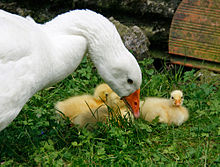Diepholz goose
| Diepholz goose | |
|---|---|
 Goose with a gander |
|
| Existence: endangered | |
| origin | Grafschaft Diepholz , Germany |
| default | |
| Weight |
|
| Colors | White |
| Ring size | 24 mm |
| Breeding instinct | excellent |
| Laying time | September to March |
| Laying performance |
|
| List of geese breeds | |
The robust Diepholz goose was bred from the land geese in the moorland of the former County of Diepholz at the end of the 19th century.
features
The Diepholz goose is a snow-white, medium-sized, rounded land goose with an orange-colored beak and reddish feet. The resilient breed resembles the gray goose in physique, apart from the white plumage, and is thus one of the easy landslides. It was repeatedly used to refine other goose breeds , such as the Lippe goose . It lays between 35 and 50 white eggs per year. She is cheerful and has clear blue eyes. This breed has a strong brood instinct, so that two natural broods per year are not uncommon. For centuries, their marching ability was in the foreground - after all, they had to be driven from Diepholz to the markets as far as Cologne and Bremen. In terms of feed intake, she is extremely undemanding and also eats sour grass. These characteristics are due to their keeping in the large moorland areas with their limited food supplies. The goose moves without problems even in steeper terrain and is therefore a robust grazing goose that is enjoying increasing popularity. A herd book has been kept in Switzerland since 1995 .
history
The Diepholz goose is one of the few remaining land goose breeds. The free and extensive form of husbandry explains their hereditary resistance and the much-praised forage gratitude. Until shortly before the Second World War , thousands of Diepholz geese were brought to the large communal pastures on the edge and into the Great Moor . Unless this area was intended for peat cutting , it was goose bumps . The animals were only herded back together when the sale was due. The rearing of the Gössel was thus natural brood and happened without human influence. The grazing goose was forced from an early age to assert itself in a numerically high herd of several thousand animals, was exposed to the weather conditions and had to defy the meager supply of sweet and sour grasses in the meadow bogs. In this wilderness it came naturally to the fact that the white “ domesticated ” herd was joined by wild gray geese from time to time. These pairings continuously stabilized the herd's robustness. The geese kept in this way could - with the exception of the cattle drive costs - be brought to the market more cheaply than animals kept in houses or farms, and even in the masses they lowered the price considerably. They were a not to be underestimated extra income for the otherwise poor and frugal Diepholz rural population. At the beginning of industrialization , roast goose was a highly valued delicacy for the growing workforce in the Rhine and Ruhr areas and in Germany's prosperous coastal cities at the end of the 19th century. In 1925 the Diepholz goose was recognized as a breed. As the demand for quill quills, down feathers and goose meat declined, it was forgotten and the large herds disappeared.
In 1994, the Diepholzer Gans, together with the Westphalian Totlegerhuhn and the Pomeranian Duck, were declared "Endangered Livestock Breed of the Year" by the Society for the Preservation of Old and Endangered Domestic Breeds (GEH).
use
The beginning hybrid breeding seemed to mean the end for the light Diepholzer goose. In hybrid breeding, heavier land cuts , such as the Emden , Pomeranian and Toulouse goose were preferred. It was and is a great advantage for the goose today that it has the weight it needs as the family size is getting smaller and smaller. Another positive aspect for the sheltered and safe housing is that the Diepholzer goose from September to March reliably hatches two broods with twelve eggs each from the second year of laying - a trait that industrial hybrid breeding likes to fall back on.
Sources and further reading
literature
- The large poultry standard in color , vol. 3. Water fowl: geese and ducks. Oertel + Spörer ISBN 3-88627-219-2
- Horst Schmidt: Large and water fowl ISBN 3-80017-315-8
- Heinrich Schierholz: Diepholzer Geese: Origin and characteristics of a robust breed . In: poultry newspaper . No. 8 , 2011, p. 13-15 ( PDF document online [accessed December 6, 2011]).
Web links
- The Diepholz goose
- Diepholzer Gans , ProSpezieRara (CH)
- Breed portrait "Diepholzer Gans" , diverse initiative for the conservation of endangered domestic animal breeds (VIEH)
- Diepholzer Gans - Endangered Breed of the Year 1994 , Society for the Preservation of Old and Endangered Pet Breeds eV (GEH)
Individual evidence
- ↑ Diepholzer Gans . Entry in the poultry lexicon of the poultry newspaper . Hobby and small animal breeder Verlagsgesellschaft mbH & Co. KG, Berlin
- ↑ National report of Germany ( page no longer available , search in web archives ) Info: The link was automatically marked as defective. Please check the link according to the instructions and then remove this notice. as a contribution to the FAO report on the state of animal genetic resources in the world, p. 50 (PDF)
- ↑ Breed tables of large and water fowl. (PDF) In: www.bdrg.de. Bund Deutscher Rassegeflügelzüchter eV (BDRG), accessed on January 9, 2012 (2.7 MB).
- ↑ Diepholzer Gänse ( page no longer available , search in web archives ) Info: The link was automatically marked as defective. Please check the link according to the instructions and then remove this notice. (PDF; 22 kB), www.entente-ee.com
- ↑ Diepholzer Gans. In: www.heimetli.ch. Retrieved January 13, 2012 .

